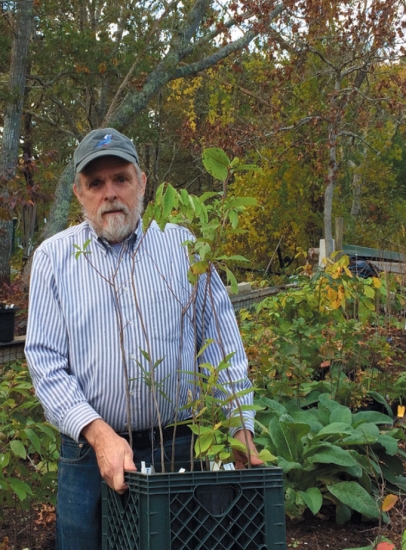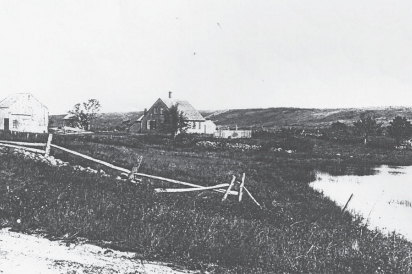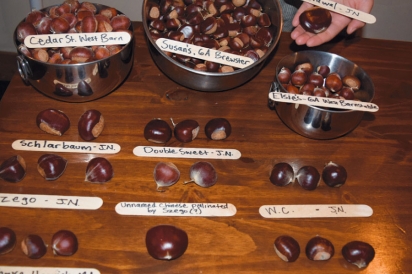A search for the tree folk
In mid October, I scattered honey locust seeds, gleaned from a neighbor’s trees, over the patch of Cape Cod soil where I had pulled up the last of my tomato crop. My sandy vegetable garden, energized but not quite vivified by compost from the Orleans transfer station, had produced good kale and Cherokee Purple tomatoes this summer, surrounded by the profusion of my mother’s wildflowers.
This garden patch, at the fringe of Critchett’s Pond in East Orleans, once belonged to the farmer Simon Sparrow. A photo of Simon’s farm in the late 1800s betrays the same severe deforestation that Thoreau chronicled in his travel journals of 1849 and 1855 entitled Cape Cod. Today the old farmland is reforested to a degree, with the pines and oaks that pioneer best on the Cape’s sandy soils, “invasive” black locusts, and more genteel plantings of later residents—a weeping purple beech and a stately walnut throwing off progeny right and left.
Cape Cod has many more trees than it had in the 1800s, yet it is still recovering from the scourge of European settlement, an event which scoured away tree diversity like no event since the Ice Age. Old growth trees became ship masts, by decree of the King; other trees became houses, fence posts, firewood, or railroad ties. Very old photographs of the Cape can be astonishing, almost unbelievable, in their treeless bleakness.
I am a latecomer to a quiet movement that has been restoring trees to the Cape landscape for a century. I believe newcomers are born every hour, and are scattered like salt throughout the Cape. Some are naturalists and conservationists, some are simple lovers of greenness. Others, like myself, self-consciously call ourselves permaculturalists or proponents of restoration agriculture. This year, as I scatter honey locust seeds where tomatoes grew, I am conscious of trading annual vegetables for a long held dream of perennial agriculture. I am casting my bet for trees.
After strewing the seeds loosely over the surface, I covered them with an inch of rough compost. The afternoon sun lit up the tired basil and chard and orange Japanese lanterns turning crisp and papery on their stalks. I know our little yard—Simon Sparrow’s plot—can never host so many honey locust trees. In my heart I am already seeing this amateur nurseryman’s contribution as part of a vast new social and ecological effort which now has a name: the Food Forest Initiative of Cape Cod. I will briefly chronicle the birth of this initiative, and try to capture its quixotic verve in an itinerary.
FIRST STOP: EDIBLE LANDSCAPES OF CAPE COD
When I moved permanently to the Cape, I did my best to find Tree People as quickly as possible. In Italy, my previous home, I had been a frustrated organic farmer, always looking over the fence and poking into other projects, wherever friends permitted me to dig holes and plant trees. At a yard sale last May in front of Brewster’s Great Cape Herb Shop, I decided to place my dogeared copy of Mark Shepard’s Restoration Agriculture in front of me, as a conversation piece, while I picked my guitar. A lanky, bearded young man (he could have been a young John Muir) strode up and announced, “That’s my Bible.” I learned that Dave Scandurra, a former Barnstable High School student and Berkeley-trained jazz percussionist, together with his partners Marina Matos and Eric Fowler, operated an Edible landscaping firm based in Brewster. They had also started a gardening, herbalism and permaculture Meetup group, which attracted over 400 members on and off-Cape. I could see that Scandurra had already done prodigious research into genetic sources of fruit and nut trees; he was also a spinner of visionary, generous-spirited ideas, such as his wish to plant forest gardens along the Cape Cod rail trail, or edible “home-run hedges” in the end-zones of high school football fields.
Scandurra and Matos started a sub-group of their original Meetup dedicated to fruit and nut trees for food security. At a first meeting, Scandurra pointed out that only one percent of the food consumed on the Cape is produced here, and that tree-based agriculture could play a major role in shoring up the difference. While he spoke, I ate a glorious fraction of that one percent, fresh bluefish with leeks and capers baked by Matos. A few days later, I found myself pitching in on a workday of the meet-up group in the sprawling garden behind Brewster’s Great Cape Herb Shop. There were fifteen or more of us weeding and chatting about permaculture and tree genetics and scattering wood-chip mulch; when we left, Scandurra “paid” us with rare perennial vegetables he had grown from seed. I absconded with skirret, scorzonera, rhubarb, lemon balm and Egyptian Walking Onion. I had no idea where I was going to plant them, but the solution was not long coming.
SECOND STOP: THE TREE PROJECT OF HARWICH
At a concert in Yarmouth, I met another Tree Person of my dreams, by pure chance, at a buffet at Yarmouth’s Cultural Center. I had mumbled something (as I often do) about trees while swallowing an olive skewered on a toothpick and Dan Corrigan picked up the conversation. He had started something called the Tree Project in Harwich with his family and friends. He was growing seven kinds of trees from seed, and sometimes from bare-root seedlings. He was nurturing and watering them until they were large enough to give away at agricultural fairs up and down the Cape. His objective, was to diversify the forests. They had been decimated and our job was to ensure that new trees, “seed trees”, got planted and cared for long enough to survive and scatter seeds. Diversity would expand on its own, like concentric ripples in a pond. In this way, he said, “We will be speeding the forest’s recovery by a factor of several thousand years.” I had apparently met someone with an unusually long view. Naturally, I invited him to attend Scandurra’s Meetup, but I also made an appointment to visit him in his Harwich home.
A week later, I knocked at his door. Soon I was wading among his young troops of knee-high trees, neatly marshaled in elongated pots to ensure luxurious, deep rooting. The healthy baby trees were paw paws, white pines, white oaks, American persimmons, pecans, shagbark hickories, and hazelnuts. Caterpillars were gnawing on some of the hazels, and I squashed them absentmindedly between two fingers, as I asked him about his commitment to trees. Corrigan had worked in the Peace Corps in Lesotho many years ago with his wife Amy. They had spawned a loving Irish family, long rooted in Harwich, but they lost one daughter, Sophia, to a car accident. Sophia had been a passionate “guerilla” tree-planter, and in her memory they kept up the tradition. It was not yet a non-profit, rather an overgrown family charity, but Corrigan had ideas for its expansion. He was keenly aware of the importance of trees in carbon capture to mitigate climate change, and he was interested in the potential use of RFIDs (radio frequency identification devices) for tagging and tracking each tree deployed to promote carbon sequestration.
I followed him to several fairs and farmers’ markets to observe him in action, and ended up walking away with free trees to plant in my own back forty, a no-man’s land of rampant vinca and multiflora rose that my mother had permitted me to tackle, only because it was outside the ken of civilization. I threw on bushels of compost to smother the weedy growth, plugged in Corrigan’s trees (two paw paws and three American persimmons), and surrounded them with Scandurra’s perennial vegetables.
THIRD STOP: A GATHERING IN TRURO
This September, at Sustainable Cape’s Agricultural Fair in Truro, Permaculture Meetup members sprawled on the grass beneath a cherry tree. The most important agenda topic that day was a mapping project.
Scandurra and Matos had already spoken of an online mapping app called Falling Fruit, and we saw its potential. We could begin prospecting for genetically important fruit and nut trees in our communities, and plot them in real time on the Falling Fruit online map, tagging them with information such as fruit quality, productivity, resistance to pests and fungus, and period of ripening. This data would enable us (or any plant researchers) to identify the genetic material that has already proven itself on Cape soils. We imagined this Falling Fruit effort as a growing constellation of layered maps. The first layer would be a public record of existing plant resources: the current adult generation of successful, healthy, majestic trees. In future, map layers would display trees grafted, cloned, or seeded from this parent generation, by future hobbyists, amateur and professional nurserymen, and schoolchildren. Layer by layer, year by year, our mapping would reveal a new, expanding cohort of trees with genetic strength, and draw together a community of active tree observers, researchers, and planters.
FOURTH STOP: THOMAS FETTIG AND KRISTIN KNOWLES’ FAMILY ORCHARD, ORLEANS
The meeting at Thomas Fettig’s home was in mid-October, and twenty members situated themselves in a circle on the grass while children raced among the irregular raised beds of trees and herbs, reminding us of the real goal of our shared visions: nature, health, freedom.
In turn, we spoke of our individual concerns and projects. Clara and Sandy McLardy, of Harwich, spoke of their intent to grow fruit trees from seed with their homeschooled children, to “allow” new varieties to emerge, and to closely observe and research their growth. Joanne Harrington spoke of her interest in collaborating to develop a “spiral” tree curriculum for the elementary school, beginning this November with an autumn sampling, by children, of many types of rare, heirloom apples, a first lesson in natural diversity. Scandurra reported that he had visited Conservation Trust lands in Barnstable County that would lend themselves to a large-scale restoration agriculture project. Then Fettig led us on a tour of his garden and we mapped his rare Gills’ Pippin and Red Burlex apple trees, training ourselves to use the Falling Fruit app. Finally, we decided it was time to give ourselves a name. Later, by common consent, our new Facebook page declared us The Food Forest Initiative of Cape Cod.
That night I noted the biggest full moon I have ever seen on Cape Cod. I woke up restless at 4:00 a.m., slipped on my running shoes, and ran down along the Nauset Inlet, toward Fort Hill, startled at the night calls of herons along Mill Pond. I wanted to reach an old pear tree I had seen growing right at the tide line, its roots spreading to where salt-loving glasswort and sea lavender grew in high water. I ran toward it with a certain urgency, imagining that I would lose its fallen fruit to scavenging raccoons; I wanted to get the pears in my bag for Clara and Sandy and their children, already imagining their careful experimentation, the “salt pears” that would grow someday at the edges of the marsh on special dream-infused, native rootstock. As soon as possible I would map the tree with my gadget, but now I was just jumping over marsh grass and rocks, enjoying my tree dream, thinking: “This is how it’s going to work out—or if not, in any case— this is life!”
At left, Chinese and hybrid chestnuts gathered by Dave Scandurra for reseeding and experimentation on the Cape. Once, the American chestnut was a prominent climax tree on Cape Cod, but it was first decimated for ship masts and telephone poles; then it was wiped out by chestnut blight in the late 1800s. Some American chestnut trees are rumored to have survived the blight on Cape Cod; these trees would be a first priority for mapping on Falling Fruit and germination and reseeding, if they can be located. Other priority species for research as food forest trees include American persimmons, paw paws, pecans, hickories, hazelnuts, honey locusts, and all locally adapted, thriving fruit trees.
If you wish to contribute or get involved, you can receive posts through the Meetup Gardening, Herbalism and Permaculture group or, alternatively, through the Food Forest Initiative, an open group on Facebook. Anyone interested in open source tree mapping can obtain for free the Falling Fruit app (which uses GPS) for smart phones, or enter the Falling Fruit online site.






